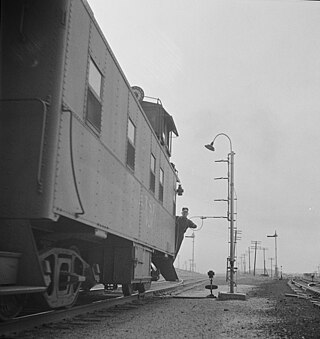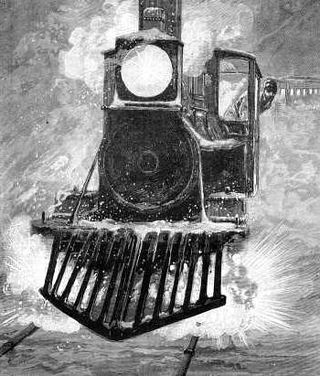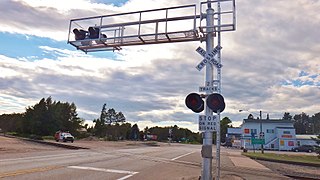
A railway signal is a visual display device that conveys instructions or provides warning of instructions regarding the driver’s authority to proceed. The driver interprets the signal's indication and acts accordingly. Typically, a signal might inform the driver of the speed at which the train may safely proceed or it may instruct the driver to stop.

Railway signalling (BE), also called railroad signaling (AE), is a system used to control the movement of railway traffic. Trains move on fixed rails, making them uniquely susceptible to collision. This susceptibility is exacerbated by the enormous weight and inertia of a train, which makes it difficult to quickly stop when encountering an obstacle. In the UK, the Regulation of Railways Act 1889 introduced a series of requirements on matters such as the implementation of interlocked block signalling and other safety measures as a direct result of the Armagh rail disaster in that year.

A signal passed at danger (SPAD), known in the United States as a stop signal overrun (SSO) and in Canada as passing a stop signal, is an event on a railway where a train passes a stop signal without authority. This is also known as running a red.

In railway signalling, an interlocking is an arrangement of signal apparatus that prevents conflicting movements through an arrangement of tracks such as junctions or crossings. In North America, a set of signalling appliances and tracks interlocked together are sometimes collectively referred to as an interlocking plant or just as an interlocking. An interlocking system is designed so that it is impossible to display a signal to proceed unless the route to be used is proven safe.
A track warrant is a set of instructions issued to a train crew authorizing specific train movements. The system is widely used in North America. The warrant is issued by the train dispatcher and delivered to the train crew via radio. The train crew copies the instructions onto a pre-printed paper form and reads back the warrant to ensure that nothing was misunderstood.

Cab signaling is a railway safety system that communicates track status and condition information to the cab, crew compartment or driver's compartment of a locomotive, railcar or multiple unit. The information is continually updated giving an easy to read display to the train driver or engine driver.

Centralized traffic control (CTC) is a form of railway signalling that originated in North America. CTC consolidates train routing decisions that were previously carried out by local signal operators or the train crews themselves. The system consists of a centralized train dispatcher's office that controls railroad interlockings and traffic flows in portions of the rail system designated as CTC territory. One hallmark of CTC is a control panel with a graphical depiction of the railroad. On this panel, the dispatcher can keep track of trains' locations across the territory that the dispatcher controls. Larger railroads may have multiple dispatcher's offices and even multiple dispatchers for each operating division. These offices are usually located near the busiest yards or stations, and their operational qualities can be compared to air traffic towers.

A train order or timetable and train order is "an order issued by or through a proper railway official to govern the movement of trains". Train order operation is the system by which trains are safely moved by train orders. It is distinguished from other forms of train operation in which the authority to move trains is given by fixed signals or cab signalling.

A track circuit is an electrical device used to prove the absence of a train on rail tracks to signallers and control relevant signals. An alternative to track circuits are axle counters.

The railway signalling system used across the majority of the United Kingdom rail network uses lineside signals to control the movement and speed of trains.
Australian railway signalling varies between the States of Australia, because the individual States are responsible for the railway systems within their own borders, with, historically, no need to co-ordinate between states except at the boundaries.

SimSig is a mixed donationware and commercial Windows-based train simulator of modern railway signalling systems in Great Britain, from the point of view of a railway signaller. Users have also had success running SimSig on Linux using Wine.
Standards for North American railroad signaling in the United States are issued by the Association of American Railroads (AAR), which is a trade association of the railroads of Canada, the US, and Mexico. Their system is loosely based on practices developed in the United Kingdom during the early years of railway development. However, North American practice diverged from that of the United Kingdom due to different operating conditions and economic factors between the two regions. In Canada, the Canadian Rail Operating Rules (CROR) are approved by the Minister of Transport under the authority of the Railway Safety Act. Each railway company or transit authority in Canada issues its own CROR rulebook with special instructions peculiar to each individual property. Among the distinctions are:

A railway detonator is a coin-sized device that is used as a loud warning signal to train drivers. It is placed on the top of the rail, usually secured with two lead straps, one on each side. When the wheel of the train passes over, it explodes, emitting a loud bang. It was invented in 1841 by English inventor Edward Alfred Cowper.

Signaling and operation on the Washington Metro system involves train control, station identification, train signaling, signage, and train length. As with any working railroad, communication between train operators, dispatchers, station personnel and passengers is critical. Failures will result in delays, accidents, and even fatalities. It is therefore important that a comprehensive signal system operated by a central authority be in place. This gives individual train and station operators the information they need to safely and efficiently perform their tasks.

Signalling block systems enable the safe and efficient operation of railways by preventing collisions between trains. The basic principle is that a track is broken up into a series of sections or "blocks". Only one train may occupy a block at a time, and the blocks are sized to allow a train to stop within them. That ensures that a train always has time to stop before getting dangerously close to another train on the same line. The block system is referred to in the UK as the method of working, in the US as the method of operation, and in Australia as safeworking.
Dark territory is a term used in the North American railroad industry to describe a section of running track not controlled by signals. Train movements in dark territory were previously handled by timetable and train order operation, but since the widespread adoption of two way radio communications these have been replaced by track warrants and direct traffic control, with train dispatchers managing train movements directly. Today most dark territory consists of lightly used secondary branch lines and industrial tracks with speeds ranging between 25 miles per hour (40 km/h) and 40 miles per hour (64 km/h); however, there do exist a small minority of main lines that fall into the category.

Level crossing signals are the electronic warning devices for road vehicles at railroad level crossings.

Communications-based train control (CBTC) is a railway signaling system that uses telecommunications between the train and track equipment for traffic management and infrastructure control. CBTC allows a train's position to be known more accurately than with traditional signaling systems. This makes railway traffic management safer and more efficient. Metros are able to reduce headways while maintaining or even improving safety.
The intermittent inductive automatic train stop is a train protection system used in North American mainline railroad and rapid transit systems. It makes use of magnetic reluctance to trigger a passing train to take some sort of action. The system was developed in the 1920s by the General Railway Signal Company as an improvement on existing mechanical train stop systems and saw limited adoption before being overtaken by more advanced cab signaling and automatic train control systems. The system remains in use after having been introduced in the 1920s.
















